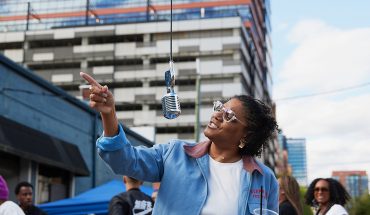
by Tina Haver Currin
photographs by Christopher T. Martin
The first thing you see when you walk into painter Eric McRay’s studio is a wall populated by small square canvases filled with colorful hearts. Inside each heart, there are emblems of North Carolina iconography, like the Krispy Kreme logo or the N.C. State Bell tower, or nods to personal motifs, or pop-culture references, all shrunk to fit into a six-by-six inch canvas. It’s a series he’s produced for five years, and the artist estimates he’s painted hundreds – if not thousands – in that time.
“It’s an excellent way for me to dive into iconography and empty myself of ideas,” he explains. McRay is quick to point out or pull references from his older work, and he moves about his compact studio space with the intimate knowledge that comes from long-term commitment. “I’ll just get on a roll and produce a huge number for a period of time.”
What McRay, 51, calls his “heart wall” is indicative of a larger trend for the artist. He refuses to be defined by a single style; instead, he builds upon the imagery and techniques he’s perfected over three decades to pump out new bodies of work.
Creating tirelessly in the studio that he’s held in downtown Raleigh’s Artspace since 1999, McRay has become a fixture of the Triangle arts scene. His work, which also includes mottled North Carolina landscapes, colorful jazz portraits, and collages of bustling cityscapes, hangs in the American Tobacco Campus and the Duke University Medical Center. While vibrant colors and an expressive, playful style are evident in his pieces, the most consistent McRay mark might be the heart that always shines through.

“His work has this false simplicity, yet the elegance, sweat, and curiosity that it took to create it is monumental,” says Lee Greene, a collector of McRay’s work who has purchased more than a dozen pieces over the last decade. “It’s deceptive, like an athlete doing something that looks so easy. That effort is years in the making.”
Prolific, entrepreneurial
On November 3, McRay unveiled a new collection at the Clayton Center, a community hub for the performing arts. Shows at Duke Hospital and the Tryon Arts Center will follow in early 2017. Each year, the painter aims to launch a series with a unique focus, and this year is no exception. Throughout 2016, McRay has focused on bold abstract paintings that lack definitive subject matter. Instead, he’s perfected working with solid chunks of acrylic paint to create colorful images that feel at once spontaneous and intensely emotional.
“Eric is very committed and very driven, and is also dedicated to teaching young artists about a variety of styles that he’s experimented with over the years,” says Mary Poole, president and CEO of Artspace. She has worked alongside McRay for 15 years.
Early in his career, the painter received a piece of advice that eventually led to his massive annual output. After he met with the owner of a small private museum who admired his paintings, the curator asked how many pieces McRay had available for sale. At the time, it was around 30. The curator told McRay that he needed at least 50 pieces to be taken seriously.
“That etched itself in my mind,” McRay says. “So, when I create new bodies of work, I’m always aiming to create at least 50 pieces in that vein. It has made me very productive and ambitious. I’ve set goals that aren’t driven strictly by passion, but more so by discipline.”

That explains the hundreds of hearts that hang in his studio, but also the scads of monochromatic nudes that he keeps in a file next to his desk, the innumerable portraits of lively saxophonists and trumpet players, and the dozens of unfinished canvases that dot his workspace.
McRay considers himself an entrepreneur as much as a painter. In fact, he estimates only a third of his time is actually spent creating the art for which he’s become so well known. Much of his painting occurs after dark, when traditional businesses have closed their doors and most workers have gone home. It’s the only time he doesn’t have to worry about typical business routines, like responding to emails, scheduling exhibitions, and chasing down invoices or bank statements.
“We tend to romanticize artists as these monks on mountaintops, like they don’t need gasoline or don’t want children or a quality of life,” McRay says, with a chuckle. Indeed, he holds his cellphone, which buzzes and beeps routinely, close to his chest. “Bottom line, everybody has to work. Last time I checked, there weren’t a ton of job openings that said, ‘Apply here for celebrity artist.’”
“He’s a bird”
As his enterprise has expanded, McRay has taken up teaching as a form of both business and artistic outreach. The painter regularly hosts classes, like his “Brilliant Coastal Scenery” workshop at the Cary Arts Center and Jerry’s Artarama for youth and adults alike. He says that working one-on-one with students brings him joy, as he’s able to pass his formal arts education on to others. McRay fondly remembers when he was the promising young student, and how much the encouragement he received from family members and teachers meant to him (though he’s not yet “the bearded elder” either, he’s quick to note).
McRay clearly recalls the moment he discovered his talent, “like Sir Isaac Newton getting struck on the head by an apple.” When his elementary-school teacher asked if anyone would like to contribute to the classroom bulletin board, the 6-year-old jumped at the opportunity to draw his version of Rumpelstiltskin. He was surprised when his teacher exited the classroom – only to return with colleagues in tow. She wanted to show them what he had created.
“For me, it was just natural. When a bird jumps out of the window and flies off, he’s not impressed with himself. He’s a bird,” McRay explains, matter-of-factly. “But when I saw that other people had this reaction, I thought, this has real value.”

From that day forward, McRay began his journey as an artist, and he’s never looked back. He began doing freelance graphic and mural design as soon as he was old enough to work, and happily owned his delegation as an “arty kid.” While in high school, McRay was awarded a scholarship to the Maryland Institute College of Art, where he received a degree in fine arts. Not long after graduating, at age 23, McRay made his way to North Carolina. He’s been here ever since.
And he’s had a front-row seat, from his perch at the corner of Davie and Blount Streets, as the Raleigh arts scene has transformed from a small pocket in a fledgling downtown to a flourishing community, complete with a contemporary art museum and a popular First Friday arts walk. Through the years, he has served as the president of the Artspace Artists Association, in addition to working on Artspace’s board of directors and serving on its executive committee.
“One of the keys to Artspace is our collaborative environment,” Poole explains. “We share ideas and techniques that spark the imagination in a way you may not get working in a private studio. It’s camaraderie.”
But McRay can recall a time – not so long ago – when he would only be asked to exhibit his work during Black History Month. As the city has grown, McRay feels that the diversity and inclusion of the arts community has grown with it. He’s never allowed himself to feel limited by what others thought his art “should” be, but McRay is glad that there are new opportunities available for young artists in the city. It’s an obvious step in the right direction, of course, but that growth doesn’t come without its challenges.
“It’s amazing for a collector to have so much vibrant choice in Raleigh,” says Greene, the collector. “On the other hand, you really have to differentiate yourself to get attention now. Eric is always asking himself, ‘How can I be a better artist?’ He keeps refining, and I have such a deep respect for that, because that’s what makes people great.”
McRay, whose friends jokingly refer to him as “his own hero,” doesn’t seem too concerned by the increased competition. “If I waited for people to come in here and praise me, I’d never get up,” he says. “The support of others is key, but there has to be a fire in your belly. I’m thankful that what I do enriches the community, but I’m just doing what I’m supposed to do. And I’m going to keep doing it. Simple as that.”



